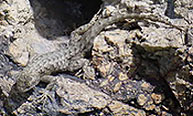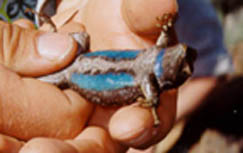Animal
List
Side-blotched
Lizard –(Uta stansburiana)-
The
Side-blotched Lizard is small. The body color is generally brown
with a double row of darker spots that run the length of its back, converging
to a single row down the tail. There is a conspicuous dark blotch on each
side, just behind the front legs. A narrow white stripe extends from the
outside corner of each eye onto the shoulder. Males, especially during
mating season, sport a dorsal cover of blue spots. Females lack this decorative
coloration.

Sagebrush
Lizard- (Sceloporus graciosus) -
The
Sagebrush Lizard can be distinguished from its relative the Western Fence
Lizard by the smaller, smoother scales, and the lack of a solid blue patch
on the throat. A pattern of gray and brown stripes runs down the length
of the back. Males have blue to black patches on each side of their underbelly,
and a mottled blue throat. While not exclusive to sagebrush plains, the
lizards do like bushy ground cover, or may inhabit rocky areas if S. occidentalis
is not present. These alert and fast hunters feed on insects and other
small invertebrates and may reach at least six inches in length. Like the
Skink, they can easily lose (and regenerate) their tail.
Western
Fence Lizard- (Sceloporus occidentalis ) -
These
close relatives of S. graciosus are brown or gray to black, have large
blue patches on the undersides of the abdomen and throat (less pronounced
in females), and have conspicuous, pointed scales on their backs.
Western
Fence Lizards tend to inhabit rocky areas but will climb on fences, trees,
or buildings. Males are territorial and use elevated perches to show off
their blue patches and attract mates. The lizards feed on insects and spiders
and can reach eight inches in length. Like the Sagebrush Lizard, Western
Fence Lizards have a tail that breaks easily under stress, but grows back
in many individuals.

Antelope-
( Antilocapra American)-
Stands
34-41” at shoulder height and is a medium sized, long-legged, deer like
herbivore. The upperbody and the outside of the legs are a pale or reddish
tan and the belly and the inner legs are white. Cheeks and jaw are white
and they have a white blaze across their tan throat. The Bucks horns are
black and are 12-20 inches when full grown. Females weight 75-105 lbs,
and males weight 90-140 pounds.
Kangaroo
Rat- (Dipodomys Microps)-
A
small nocturnal animal that has large, strong hind legs, and a large tail
with weak forelegs. Are considered friendly and will accept humans. They
have fur lined check pouches, which they compulsively gather seeds in.
They also eat greens, and insects. They also do not require a steady supply
of water, they may drink a couple drops from a puddle once in a while,
but constant water is not required.
Mule
Deer- ( Odocoileus hemionus)-
Stands
90-110cm tall at the shoulder and is the most common mountain deer. They
have a tawny coat with a light underside and rump. They usually have a
light nose with a black tip and large ears. They have a white tail with
a black tip and their antlers branch to form “Y” junctions. They eat a
variety of grasses, forbs and leaves and in the winter more of twigs, buds,
and branches.
Jack
Rabbit- (Lepus californicus)-
The
Black tailed jackrabbit is the variety we saw. This Rabbit is distinguished
by its enormous ears, that are nearly 1/3 the size of its body. It also
has a long tail that kind of sticks up as it jumps along.
Cottontail
Rabbit-
The
cottontail is a smaller brown rabbit with large eyes and ears. The rabbit
was named for its small white tail that resembles a cotton swab.
Yellow-bellied
Marmot- (Rodentia marmota)-
The
Marmot is a large burrowing animal, with a small head and ears, a long
torso, short legs and a thin tail 1/3 the size of its body.
Back to Plants and Animals
Back to the Home Page
